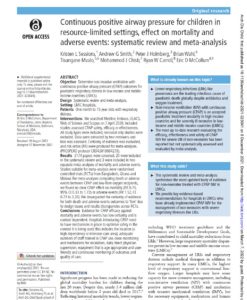
Introduction
Significant progress has been made in reducing the global mortality burden for children during the last 20 years. Despite this, nearly 5.4 million children worldwide below 5 years old died in 2017. Reflecting historical mortality trends, lower respiratory infections (LRIs) are disproportionately represented, accounting for more deaths among 1–59 month olds than any other illness. Various efforts, including WHO treatment guidelines and the Millennium and Sustainable Development Goals, have contributed to child mortality reductions from LRIs.1 However, large respiratory mortality disparities persist in low-income and middle-income countries (LMICs).
Current management of LRIs and respiratory distress include medical therapies in addition to respiratory support. In many LMICs, the highest level of respiratory support is conventional low-flow oxygen. Larger hospitals may have some capacity for more intensive management, including non-invasive ventilation (NIV) with continuous positive airway pressure (CPAP) and intubation with invasive mechanical ventilation (IMV), but the necessary equipment, medications and human resource capacity makes this infrequent.
Interventions
We searched Medline, Embase, LILACS, Web of Science and Scopus on 7 April 2020. Included studies assessed CPAP safety, efficacy or effectiveness. All study types were included; neonatal only studies were excluded. Data were extracted by two reviewers and bias was assessed. Certainty of evidence was evaluated, and risk ratios (RR) were produced for meta-analyses. (PROSPERO protocol CRD42018084278).
Results
2174 papers were screened, 20 were included in the systematic review and 3 were included in two separate meta-analyses of mortality and adverse events. Studies suitable for meta-analysis were randomised controlled trials (RCTs) from Bangladesh, Ghana and Malawi. For meta-analyses comparing death or adverse events between CPAP and low-flow oxygen recipients, we found no clear CPAP effect on mortality (RR 0.75, 95% CI 0.33 to 1.72) or adverse events (RR 1.52, CI 0.71 to 3.26). We downgraded the certainty of evidence for both death and adverse events outcomes to ‘low’ due to design issues and results discrepancies across RCTs.
What is already known on this topic?
- Lower respiratory infections (LRIs) like pneumonia are the leading infectious cause of paediatric death globally despite antibiotics and oxygen treatment.
- Non-invasive ventilation (NIV) with continuous positive airway pressure (CPAP) is an accepted paediatric treatment modality in high-income countries and for severely ill neonates in low-income and middle-income countries (LMICs).
- The most up-to-date research evaluating the efficacy, effectiveness and safety of CPAP NIV for severe LRI of non-neonates has been reported but not systematically assessed and evaluated by meta-analysis.
What this study adds?
- This systematic review and meta-analysis synthesises the most updated body of evidence for non-neonates treated with CPAP NIV in LMICs.
- We provide key evidence-based recommendations for hospitals in LMICs who have already implemented CPAP NIV for the management of non-neonates with severe respiratory illnesses like LRIs.